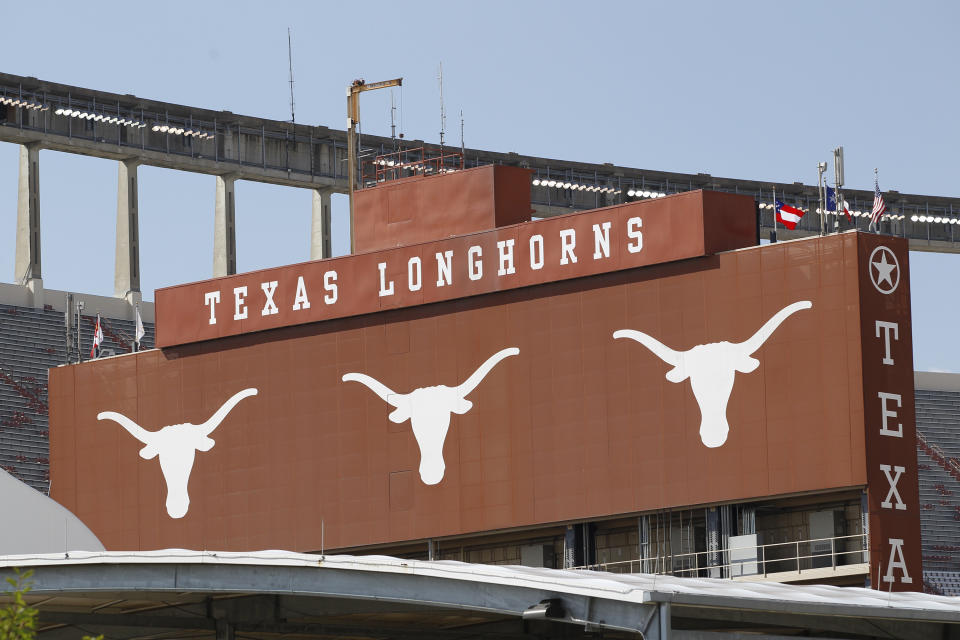Texas to rename football field for Earl Campbell, Ricky Williams as part of campus diversity initiatives
The University of Texas is implementing an array of initiatives and changes as part of its effort to create “a more diverse and welcoming campus,” and some of the changes involve the football program.
The school announced Monday that the field at Darrell K Royal-Texas Memorial Stadium will be named after Heisman Trophy-winning running backs Earl Campbell and Ricky Williams. The field had been named Joe Jamail Field since 1997, but the Jamail family suggested the field be renamed for Campbell and Williams, UT said. Jamail, who died in 2015, donated millions to UT.
Additionally, a statue of Julius Whittier, the first Black football letterman at Texas, will be erected at the stadium.
The changes, which were announced in a letter written by interim university president Jay Hartzell, were made after “challenging, fulfilling and eye-opening” conversations with students about how Texas “can promote diversity, inclusion and equity and fully support Black students.”

Those conversations came after the death of George Floyd and the nationwide social unrest that has followed. Last month, several Texas football athletes shared a statement asking for campus-wide changes, including renaming certain buildings, renaming a portion of the football stadium after Whittier, adding a Black history exhibit to the school’s athletics hall of fame and replacing “The Eyes of Texas” as UT’s alma mater. The athletes said the song has “racist undertones.”
While many changes are being made, Hartzell said “The Eyes of Texas” will remain. Hartzell said the school will “own, acknowledge and teach about all aspects of the origins” of the song “as we continue to sing it moving forward with a redefined vision that unites our community.”
“The Eyes of Texas” dates back to a minstrel show from the early 1900s that featured performers in Black face. Hartzell acknowledged that the origins of the song have “created a rift in how the song is understood and celebrated.”
“‘The Eyes of Texas,’ in its current form, will continue to be our alma mater,” Hartzell wrote. “Aspects of its origin, whether previously widely known or unknown, have created a rift in how the song is understood and celebrated, and that must be fixed. It is my belief that we can effectively reclaim and redefine what this song stands for by first owning and acknowledging its history in a way that is open and transparent.
“Together, we have the power to define what the Eyes of Texas expect of us, what they demand of us, and what standard they hold us to now. ‘The Eyes of Texas’ should not only unite us, but hold all of us accountable to our institution's core values. But we first must own the history. Only then can we reimagine its future, and I look forward to partnering with our campus community to do just that.”
Though the alma mater will remain, many Texas football players took to Twitter to support the initiatives. One player, DeMarvion Overshown, vowed to sit out athletic activities “until real action” was taken and “until we are one.” On Monday, Overshown tweeted “We Are One!”:
We Are One! 🤘🏾 https://t.co/azqOJvIfLc
— DeMarvion Overshown (@dee_overshown6) July 13, 2020
Longhorns head coach Tom Herman was very pleased with Monday’s news.
So very proud of our players, all Texas student-athletes, our entire student population and university leadership. They will forever be known for being responsible for tangible, positive change on our great campus. Today is a great first step. #HookEm 🤘🏼 https://t.co/ftYQpgPk3G
— Coach Tom Herman (@CoachTomHerman) July 13, 2020
On-campus changes being made
Hartzell said Texas hopes to attract, retain and support talented and diverse students, faculty and staff. To do so, money from UT athletics will be allocated to programs “that work to recruit, attract, retain and support Black students.” Among those efforts will be expanding UT’s presence in cities like like Dallas, Houston and San Antonio to recruit students from “underrepresented groups” and establish additional scholarships for those students. UT also wants to feature a “broader range of students” on its UT Austin Police Oversight Committee.
On campus, the building named after Robert L. Moore — a former math professor who refused to teach Black students — will be renamed the Physics, Math and Astronomy Building. Within the building, “historical explanations within the building about why past university leaders chose to name the space for Professor Moore” will be present.
The school’s first Black undergraduates, known as the Precursors, will be honored with a new monument. Additionally, Heman M. Sweatt — who challenged segregationist views all the way to the Supreme Court, allowing him and other Black students to attend UT — will be further honored with a statue, the entrance named in his honor and an exhibit both in Painter Hall.
This will recognize Mr. Sweatt's courage and leadership in changing the world through the 1950 case that he won, allowing him and other Black students to attend UT. This will also place Painter Hall within the context of our university's resistance to integration under T.S. Painter's presidency, and ultimately to the Sweatt v. Painter decision's crucial role in integrating public education.
More from Yahoo Sports:

